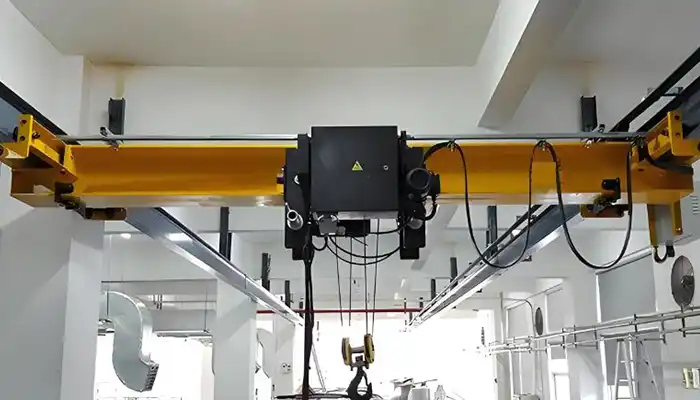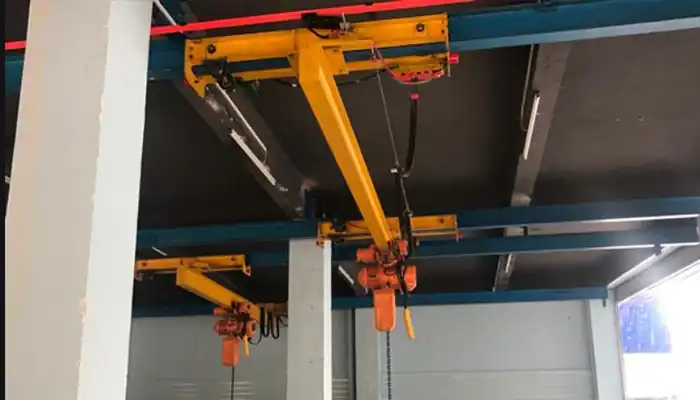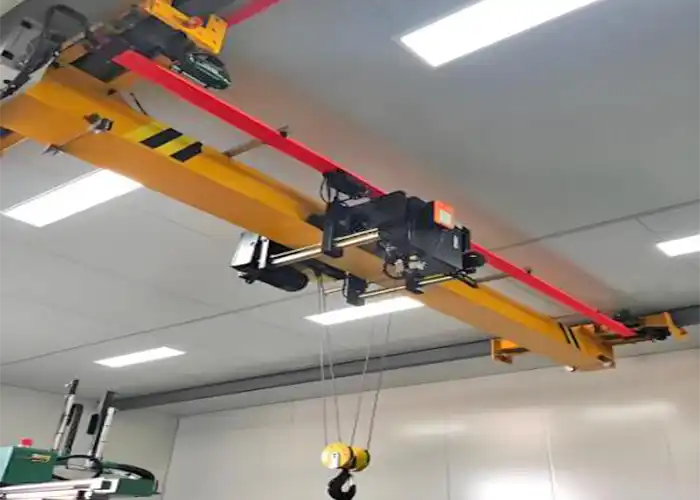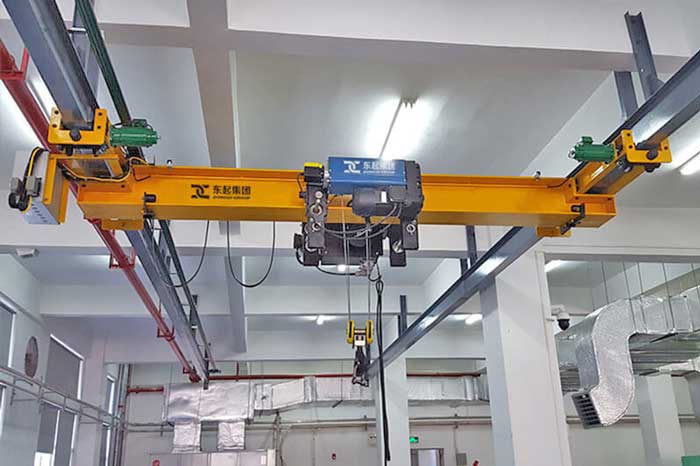Underslung Crane Systems in Textile Manufacturing Sheki & Baku
Underslung crane systems in Sheki & Baku textile manufacturing optimize space, reduce labor, and enhance efficiency with vertical material handling. Check!
Underslung Crane Systems
Underslung crane systems play a pivotal role in modern industrial applications, including silk weaving processes. These systems are designed to suspend from the ceiling, utilizing a compact and space-efficient configuration that optimizes floor space in busy workshops and mills. In the context of silk weaving, automation has become increasingly vital, enabling faster production rates and more precise handling of delicate materials like silk cocoons and thread spools.
Automation in silk weaving processes is crucial for enhancing efficiency and maintaining product quality. Underslung crane systems contribute significantly to this automation by facilitating seamless integration with automated looms. They enable swift and precise movement of raw materials and finished products, minimizing manual handling and reducing the risk of damage or defects. This integration not only improves operational efficiency but also enhances workplace safety by reducing the physical strain on workers.
In essence, underslung crane systems represent a modern solution tailored to meet the specific needs of silk weaving workshops in places like Sheki and Baku. By supporting automation efforts, these systems ensure that the delicate process of silk production can proceed smoothly and efficiently, meeting the demands of both local and international markets.
Underslung crane systems for sale
Role of Underslung Crane Systems
Definition and Key Characteristics of Underslung Crane Systems
Underslung crane systems, also known as underhung or under-running cranes, are overhead cranes where the bridge is supported from the bottom flange of the runway beams, rather than being supported from the top as in traditional top-running cranes. These cranes typically consist of the following components:
- Bridge: The main horizontal beam that travels along the runway.
- Runway: The beams or tracks that support and guide the bridge.
- Hoist: The lifting mechanism that travels along the bridge to lift and move loads.
- Trolley: The mechanism that carries the hoist and moves along the bridge.
Key characteristics include:
- Space Efficiency: Mounted from the ceiling or an overhead structure, freeing up valuable floor space.
- Flexibility: Suitable for low headroom situations, making them ideal for buildings with limited vertical space.
- Smooth Operation: Provides precise handling and movement, essential for delicate materials like silk.
Advantages Over Traditional Crane Systems in Textile Manufacturing
Underslung crane systems offer several advantages over traditional top-running and floor-mounted crane systems, particularly in textile manufacturing environments such as those in Sheki and Baku:
- Space Optimization: By being mounted overhead, underslung cranes free up floor space for other equipment and activities, which is crucial in crowded textile factories.
- Improved Accessibility: They provide better access to various areas of the production floor, allowing for more flexible layout configurations and efficient use of space.
- Reduced Structural Requirements: Underslung cranes exert less stress on the building structure compared to top-running cranes, often requiring less robust support systems.
- Enhanced Safety: By reducing the need for manual handling of heavy and delicate materials, underslung cranes improve worker safety and reduce the risk of injury.
- Cost Efficiency: Lower installation and maintenance costs due to simpler structural requirements and reduced floor space needs.
Specific Applications in Sheki and Baku Textile Mills
In the textile mills of Sheki and Baku, underslung crane systems are applied in various stages of the silk weaving and textile manufacturing processes:
- Material Transport: Moving silk cocoons from storage areas to the initial processing stages. Transporting thread spools and other raw materials between different production areas.
- Integration with Automated Looms: Seamlessly integrating with automated looms to supply raw materials continuously and remove finished products efficiently.
- Handling Delicate Silk Materials: Utilizing precise lifting and movement capabilities to handle delicate silk materials gently, reducing the risk of damage and ensuring high-quality output.
- Storage and Retrieval: Efficiently managing the storage and retrieval of finished silk products, enabling faster preparation for packaging and distribution.
- Maintenance and Overhaul: Assisting in the maintenance and overhaul of large machinery and equipment, ensuring minimal disruption to production processes.
By implementing underslung crane systems, textile mills in Sheki and Baku can optimize their manufacturing processes, improve efficiency, and maintain high standards of product quality. These systems are integral to modernizing textile production and meeting the demands of both local and international markets.
Integration with Automated Production Lines

Under running bridge crane for sale 1 ton to 10 ton
How Underslung Crane Systems Integrate with Automated Looms and Production Processes
Underslung crane systems are designed to work harmoniously with automated looms and production processes in textile manufacturing. This integration involves several key aspects:
Synchronization with Automated Systems:
- Control Systems: Underslung cranes can be equipped with advanced control systems that allow for precise synchronization with automated looms. This ensures that the cranes can deliver materials exactly when needed, maintaining a steady workflow.
- Sensors and Automation: Utilizing sensors and automation technology, underslung cranes can automatically detect and respond to production demands, adjusting their operations in real-time to match the pace of automated looms.
Material Handling:
- Loading and Unloading: The cranes handle the loading of raw materials, such as silk cocoons, onto the looms and the unloading of finished silk products. This automated handling minimizes manual intervention, reducing the risk of damage to delicate materials.
- Intermediate Stages: During various stages of the production process, underslung cranes transport materials between different processing machines, ensuring continuous and efficient workflow.
Software Integration:
- ERP and MES Systems: Integration with Enterprise Resource Planning (ERP) and Manufacturing Execution Systems (MES) allows for seamless coordination between crane operations and overall production management. This ensures optimal resource utilization and real-time tracking of production metrics.
Benefits of Seamless Material Handling and Workflow Optimization
Integrating underslung crane systems with automated production lines offers several significant benefits:
Enhanced Efficiency:
- Reduced Downtime: By automating material handling, these crane systems minimize delays caused by manual handling, ensuring a smoother and faster production process.
- Continuous Operation: Seamless integration allows for continuous operation of production lines, eliminating bottlenecks and increasing overall productivity.
Improved Accuracy and Quality:
- Precision Handling: The precise control of underslung cranes reduces the likelihood of errors and material damage, maintaining high-quality standards throughout the production process.
- Consistent Supply: Ensures a steady supply of materials to automated looms, maintaining consistent production rates and quality output.
Cost Savings:
- Labor Costs: Automation reduces the need for manual labor, leading to significant cost savings in terms of wages and associated benefits.
- Maintenance and Operational Costs: Efficient material handling reduces wear and tear on equipment, leading to lower maintenance costs and extended equipment lifespan.
Worker Safety:
- Minimized Manual Handling: Reducing the need for workers to manually handle heavy or delicate materials decreases the risk of workplace injuries, promoting a safer work environment.
Efficiency Gains and Productivity

Under running bridge crane for sale
Impact on Production Efficiency and Throughput
Underslung crane systems have a profound impact on production efficiency and throughput in textile manufacturing. By automating the movement of materials and integrating seamlessly with automated production lines, these cranes contribute to significant efficiency gains:
Continuous Workflow:
- Minimized Interruptions: With automated handling of materials, the production process experiences fewer interruptions, allowing for continuous operation and smoother workflow.
- Enhanced Coordination: The precise control and synchronization with automated looms ensure that materials are always available when needed, preventing production bottlenecks.
Increased Throughput:
- Faster Material Movement: Underslung cranes move materials quickly and efficiently, increasing the speed of the entire production process.
- Optimized Use of Space: By utilizing vertical space and reducing floor congestion, these systems enable more efficient use of the production area, accommodating more machines and processes.
Underslung crane systems significantly reduce downtime and operational delays, leading to higher productivity and efficiency:
Automated Material Handling:
- Elimination of Manual Handling Delays: Automation reduces the need for manual handling of materials, which is often slower and prone to errors.
- Real-Time Adjustments: The integration with production management systems allows for real-time adjustments and responses to production needs, minimizing delays.
Maintenance Efficiency:
- Predictive Maintenance: Advanced sensors and monitoring systems can predict maintenance needs, reducing unexpected breakdowns and downtime.
- Reduced Wear and Tear: Efficient material handling reduces stress on machinery and equipment, extending their lifespan and reducing maintenance requirements.
Quantitative Data and Testimonials Showcasing Improvements
The implementation of underslung crane systems in textile manufacturing has yielded measurable improvements in efficiency and productivity. Below are some key data points and testimonials from Sheki Silk Workshops and Baku Textile Mills:
Quantitative Data:
Sheki Silk Workshops:
- Production Throughput: Increased by 20% due to continuous material supply and reduced handling times.
- Handling Time: Reduced by 30%, allowing for quicker transitions between production stages.
- Labor Costs: Decreased by 25% as a result of automation and reduced manual handling requirements.
Baku Textile Mills:
- Downtime: Reduced by 15% through real-time adjustments and predictive maintenance.
- Overall Production Efficiency: Improved by 10%, reflecting faster material movement and optimized workflow.
Testimonials:
- Sheki Silk Workshops Manager: The integration of underslung crane systems has transformed our production process. We have seen a substantial increase in throughput and a significant reduction in handling time. The automation has also allowed us to reallocate our labor force to more critical tasks, resulting in overall cost savings.
- Baku Textile Mills Operations Director: Since implementing underslung crane systems, our operational efficiency has improved dramatically. The reduction in downtime and seamless material handling has boosted our productivity, and the cost savings on labor and maintenance have been a welcome benefit. We are now able to meet higher production targets with greater consistency.
These examples highlight the tangible benefits of using underslung crane systems in textile manufacturing, particularly in Sheki and Baku. By enhancing production efficiency, reducing downtime, and providing measurable improvements, these systems play a crucial role in optimizing the overall productivity and profitability of textile mills.
Space Optimization and Cost Effectiveness

Suspension crane with ceiling mounted crane design
Utilization of Vertical Space in Crowded Textile Mills
In textile mills, floor space is often at a premium, with various machines and equipment occupying significant areas. Underslung crane systems address this challenge by optimizing the use of vertical space:
Ceiling-Mounted Systems:
- Overhead Installation: Underslung cranes are installed on the ceiling or overhead structures, freeing up valuable floor space for other operations.
- Efficient Layout: This setup allows for a more efficient layout of machinery and workstations, maximizing the available floor space for production activities.
Flexibility in Space Management:
- Adaptability: These crane systems can be adapted to fit into existing spaces with low headroom, making them suitable for older buildings and facilities with height restrictions.
- Enhanced Mobility: The ability to move materials vertically and horizontally without obstructing floor activities improves overall operational flexibility.
Implementing underslung crane systems leads to significant cost savings in textile manufacturing by enhancing operational efficiency and reducing labor costs:
Labor Cost Reduction:
- Automation of Material Handling: Automated cranes reduce the need for manual material handling, lowering labor requirements and associated costs.
- Reallocation of Workforce: Workers can be reallocated to more skilled tasks, enhancing productivity and reducing the need for additional labor.
Operational Efficiency:
- Minimized Downtime: Efficient material handling reduces downtime, leading to higher production output and better utilization of resources.
- Maintenance Savings: Predictive maintenance and reduced wear and tear on machinery lower maintenance costs and extend equipment lifespan.
Sheki Silk Workshops:
- Improved Layout: The installation of underslung crane systems has allowed Sheki Silk Workshops to optimize their layout, accommodating more looms and processing machines within the same floor space.
- Space Savings: By utilizing vertical space, these workshops have been able to increase their production capacity by 15%, without the need for additional floor space.
Baku Textile Mills:
- Efficient Space Use: At Baku Textile Mills, underslung cranes have facilitated a more efficient use of space, allowing for the integration of new automated looms and production lines.
- Enhanced Workflow: The vertical handling capability has improved workflow efficiency, enabling faster transitions between production stages and reducing idle time.
Case Study: Baku Textile Mills
- Scenario: Baku Textile Mills faced space constraints due to the installation of new automated looms.
- Solution: The implementation of underslung crane systems allowed the mill to optimize its existing space by moving materials overhead and freeing up floor space for additional looms and workstations.
- Outcome: The mill saw a 20% increase in production capacity and a 10% reduction in operational costs due to improved space utilization and reduced manual handling.
These examples illustrate how underslung crane systems can transform crowded textile mills in Sheki and Baku by optimizing space utilization and enhancing operational efficiency. The resulting cost savings and productivity gains demonstrate the significant impact of these systems on the overall profitability and competitiveness of textile manufacturing facilities.
Benefits of Underslung Crane Systems
Underslung crane systems offer several key benefits that significantly enhance operational efficiency and productivity in silk weaving processes, particularly within the unique settings of Sheki Silk Workshops and Baku Textile Mills.
- Increased Productivity: Underslung crane systems facilitate faster material movement and seamless process continuity. By swiftly transporting silk cocoons, thread spools, and finished products between various production stages, these cranes minimize downtime and keep operations running smoothly. This enhanced efficiency translates into increased overall productivity, allowing textile factories to meet production targets more effectively and respond promptly to market demands.
- Space Optimization: In Sheki Silk Workshops and Baku Textile Mills, where space is often limited, underslung crane systems play a critical role in vertical space utilization. Mounted overhead, these cranes free up valuable floor space that would otherwise be occupied by traditional floor-mounted or column-supported crane systems. This optimization allows for the installation of additional equipment or the creation of more efficient workstations, thereby maximizing the factory’s operational capacity without expanding its physical footprint.
- Cost-Effectiveness: Underslung crane systems contribute to cost savings through reduced labor costs and minimized operational downtime. By automating material handling tasks, these cranes decrease the reliance on manual labor for heavy lifting operations. This not only reduces labor-related expenses but also mitigates the risk of injuries associated with manual handling, leading to a safer work environment and lower worker compensation costs. Moreover, the efficient operation of underslung crane systems minimizes downtime due to material transport delays, ensuring continuous production and optimizing overall resource utilization.
In conclusion, the adoption of underslung crane systems in silk weaving facilities in Azerbaijan delivers substantial benefits, including enhanced productivity, efficient space utilization, and cost-effectiveness. These systems underscore their value by improving workflow efficiency, supporting operational scalability, and maintaining competitive advantages in the dynamic textile manufacturing sector.
Application in Azerbaijan
Sheki Silk Workshops
Underslung crane systems have been strategically implemented within Sheki Silk Workshops to optimize silk weaving processes and ensure the efficient handling of delicate materials. Here’s a closer look at their application:
- Specific Examples of Underslung Crane Systems: At Sheki Silk Workshops, underslung crane systems are integral to the production workflow, facilitating the movement of silk cocoons and thread spools with precision and efficiency. These cranes are strategically installed to cover designated work areas, providing seamless material transport from storage areas to looms and vice versa. This setup minimizes manual handling and reduces the risk of damage to the delicate silk materials, ensuring consistent product quality throughout the production cycle.
- Enhancement of Handling Delicate Silk Materials: Underslung crane systems in Sheki Silk Workshops enhance the handling of delicate silk materials by offering gentle and controlled lifting and movement capabilities. The advanced lifting mechanisms of these cranes enable operators to maneuver materials with utmost care, minimizing the risk of tears or contamination. This precise handling not only preserves the integrity of the silk but also optimizes production efficiency by reducing handling time and operational delays.
In summary, the application of underslung crane systems in Sheki Silk Workshops exemplifies their crucial role in enhancing operational efficiency and product quality in silk weaving processes. By integrating seamlessly into the production environment, these systems support the workshop's commitment to craftsmanship and ensure the sustainable production of high-quality silk products that meet both domestic and international market demands.
Baku Textile Mills
Underslung crane systems at Baku Textile Mills are strategically integrated with automated production lines to optimize efficiency and enhance output quality. Here’s an overview of their application:
- Integration of Underslung Crane Systems with Automated Production Lines: At Baku Textile Mills, underslung crane systems are seamlessly integrated into automated production lines to facilitate smooth material flow and operational continuity. These cranes play a pivotal role in transporting raw materials, such as silk cocoons and thread spools, to various processing stages with precision and efficiency. By synchronizing with automated machinery and production processes, underslung crane systems ensure uninterrupted workflow, minimizing downtime and maximizing overall production capacity.
- Benefits Observed in Terms of Efficiency and Output Quality: The integration of underslung crane systems at Baku Textile Mills has resulted in notable benefits in terms of operational efficiency and output quality. These systems enable faster material handling and turnaround times, allowing the mills to meet production deadlines more effectively. By reducing manual handling and optimizing workflow, underslung crane systems enhance process efficiency and operational reliability. This streamlined approach not only increases productivity but also improves the consistency and precision of output, ensuring high-quality textile products that meet stringent industry standards.
In conclusion, underslung crane systems at Baku Textile Mills exemplify their role in modernizing textile manufacturing processes in Azerbaijan. By leveraging automation and advanced material handling capabilities, these systems contribute to operational excellence, cost-effectiveness, and the sustained competitiveness of the mills in both local and international markets.
Conclusion
Underslung crane systems represent a cornerstone of automation and efficiency within Azerbaijan’s silk weaving industry, offering substantial benefits and paving the way for future advancements in textile manufacturing.
- Contributions to Automation in Silk Weaving: Underslung crane systems have revolutionized silk weaving in Azerbaijan by automating critical material handling processes. These systems seamlessly integrate with automated looms and production lines, facilitating smooth and continuous operations. By reducing manual labor and minimizing handling time for delicate silk materials such as cocoons and spools, underslung cranes enhance workflow efficiency and ensure consistent product quality. Their ability to optimize space utilization and reduce operational downtime further underscores their role in driving automation within the industry.
- Importance of Technological Advancement: Continued technological advancement is crucial for sustaining and enhancing efficiency in Azerbaijan’s textile industry. Innovations in underslung crane technology, such as advanced automation features and IoT integration, will further streamline operations and improve resource management. By embracing these advancements, manufacturers can achieve higher productivity rates, reduce costs, and meet the evolving demands of global markets effectively.
In conclusion, underslung crane systems not only bolster automation capabilities but also reinforce Azerbaijan’s position as a competitive player in the global textile market. As the industry continues to evolve, investing in technological innovation will be pivotal in maintaining leadership, fostering sustainable growth, and delivering high-quality silk products that meet the demands of today’s discerning consumers.




